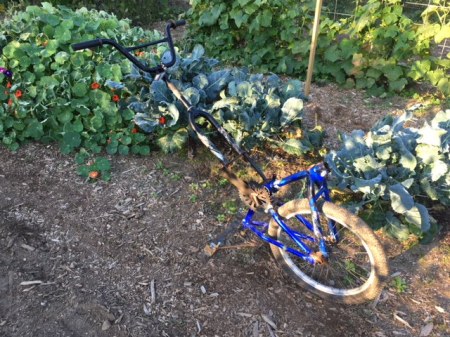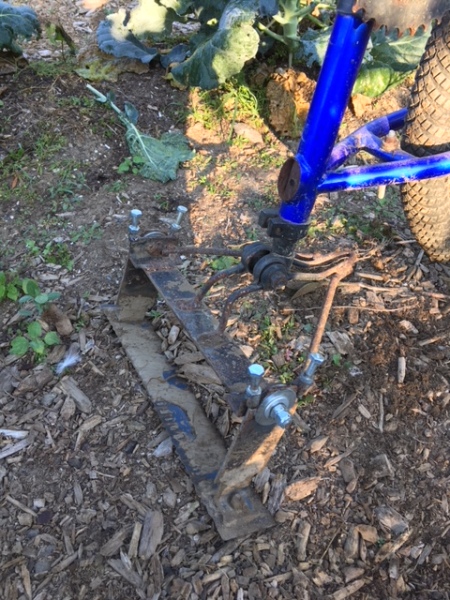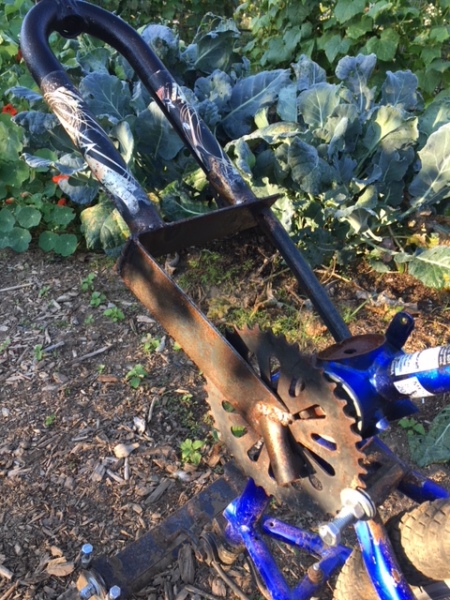We have a good-sized garden in Gorham (about 4,000 square feet) and particularly in midsummer there’s a lot of weeding to do. We’ve tried mulching the aisles between the beds with wood chips; the driveway ends on a very busy main road, and I put up a sign asking for chips that resulted in over 100 cubic yards arriving one day. The chips work well if we put down a thick layer, but if we don’t go thick enough or skip a year the weeds come right up through, and hauling the chips is hard work.
We have a medium-sized rototiller, but the engine is old and finicky, and using a particularly nasty old fossil-fueled engine for routine cultivation seems like the wrong move. An ordinary garden hoe is an acceptable solution, but it’s not such enjoyable work that it gets done frequently enough to keep things tidy, and in past years at some point in the summer the garden gets away from us, and the weeds mingle freely with the vegetables.
The old timers had a nice solution, the wheel-hoe. One large metal wheel in front, some sort of cultivation tool behind the wheel at ground level, and a pair of handles sweeping up and back to a comfortable working height. Somewhere online I read an article about making a wheel hoe out of bike parts, and this spring I gave it a shot. I’m very happy with the result, and think there is a lot of potential in general for bike-hacking to build small-scale agricultural equipment.

I put in a request with Dave and Emily for some dump bikes, and they quickly came up with four kid-sized BMX bikes in various states of disrepair. I wasn’t sure exactly what I wanted, so I designed the tool to take advantage of all the degrees of freedom the bike parts could offer. The basic concept was to use the rear wheel and rear triangle of the bike frame as the main structure, with the seat tube opening pointed down and a modified seat as the basis for the tool. I hacked the plastic off a seat, leaving the curved, roughly V-shaped steel seat support to weld an implement onto. I took advantage of the linear and angular adjustability of the bike seat to enable adjustment of the depth and angle of attack of the implement.

The first implement I built was an oscillating stirrup hoe – modeled after commercially available products like this one from Johnny’s. I used the steel blade of an old handheld swinging weed cutter for the double-sided blade, and hacked up some light steel plate, angle, coupler nuts, and small bolts to create the frame and adjustable oscillating swing. The oscillating action allows the stirrup to cut in both directions, with the drag of the soil swinging the blade to create an angle of attack that lifts the soil and cuts the roots of the weeds.

I wanted to use the handlebars of the bike for the handles of the wheelhoe, but I wasn’t sure about the angle or length, so I hit on what I think is a pretty clever hack. I use the handlebar/fork assembly of a bike as received, but welded the fork end to the end of one of the crank arms, using a piece of 1/8×2″ strap steel as an adapter. Of course, the crank arm on the other side of the bottom bracket points the opposite direction, so I cut it and scabbed in another piece of plate steel to complete the structure. The handle was then in place (with the headset height and handlebar adjustments still viable), but swinging freely on the rusty bearings of the bottom bracket. I could have just welded the bottom bracket into a solid mass, but to retain adjustability I welded a 3/8″ coupler nut to the kickstand mount on the bike frame, positioned such that a bolt tightened down on it would fit exactly in one of the teeth of the front chainring, such that the angle of the handlebar assembly could be adjusted in increments of one sprocket pitch. I jammed a bolt down tightly to clamp the chainring to the coupler nut and fix the handlebars rigidly in place.
All of the stick welding I’ve done has been on fairly heavy metal, but for this project I bought some very small rod and got some practice welding at minimum current on bike frame tube and other light metal. If I were going to get into this in a serious way I’d want a wirefeed welder and maybe a TIG.
Once I got the basic unit built and saw that it worked well, I went all out and cut another seat tube off a different bike, welding the bottom brackets together such that the hoe could have two different implements that could be alternated by flipping the hoe 180 degrees about its long axis. I then made a dual toolbar out of another bike seat and some 3/4″ square tube, and attempted a spring-tooth harrow using beam clamps to attach to the square tube and curved 3/8″ rod for the teeth. But the teeth seemed too springy, and jamming nuts against the threaded holes in the beam clamp was not sufficient to prevent the teeth rotating out of the vertical plane. I’m pretty sure that by fabricating some thinner, sharper teeth out of plate I could make a workable tool, but I used it enough to tell that it was going to be much harder work than the stirrup hoe, so I gave up on that for the season, relying on the broadfork I bought from Johnny’s to do any heavier cultivation.
All of this fabrication happened in the spring, much of it with hand tools in the basement in the early morning, with Z on my front in a Moby baby sling, and grabbing free moments to do the welding and grinding. In many cases this type of project is fun to execute, but then sits collecting dust, but in this case I’m pleased to report that I continued using the tool all summer, that I found it consistently enjoyable, and that the garden was markedly less weedy as a result. I am very happy with the outcome of the project, and I plan to make at least one more, to give to my parents for their farmstand garden. I can’t say anything about particular commercial models, but in general I’d say a wheelhoe is a great tool for serious home gardeners.
If/when I make another one, one worthwhile change would be to add a couple inches to the vertical arms of the oscillating stirrup, because the current clearance tends to clog up and plow a pile when cultivating thicker weeds or mulchy soil. It’s not a big deal, I just reverse direction to clear it, but I think the problem could be easily alleviated.
Another possible change would be to add one or more sweeps behind the stirrup, to push the loosened soil to the side. Kelsey noticed that the edges of the slightly raised beds would get eroded over time, and having the ability to mound the soil up (whether in the same pass, or on a subsequent pass using a different implement in the other seat tube) would help with that. However, with our sandy well-drained soil I don’t think we actually need the beds to be raised; if they were slightly depressed that would help with the watering, though I think they naturally end up raised from compost etc.
If we ever got into more serious row crops, people have made some pretty sophisticated wheelhoes, including with two wheels and a high arch to pass on either side of a row of corn, miniature disk harrows for hilling, etc. And perhaps the ultimate solution would be a pedal/electric hybrid tractor, with a solar panel canopy and two pedaling positions, one to propel the unit and the other to run an implement. That would require a lot more space and broad areas at the end of each row for turning.
